Research on Macroscopic Mechanical Behavior of Recycled Aggregate Concrete Based on Mesoscale
Abstract
1. Introduction
2. Numerical Simulation Scheme
2.1. Mesoscopic Model
2.2. Failure Criteria
2.3. Material Parameter
3. Simulation Results and Discussion
3.1. Effects of Different Aggregate Substitution Rates
3.1.1. Stress–Strain Relationship
3.1.2. Mesoscopic Damage Evolution
3.2. Effects of Different Strain Rates
3.2.1. Stress–Strain Relationship
3.2.2. Mesoscopic Damage Evolution
4. Conclusions
- (1)
- With the increase in the replacement rate of recycled aggregate, the peak stress first decreases and then increases, and the peak strain keeps increasing. Since the overall stress of the material depends on the balance of the aggregate strength, the closer the aggregate strength is, the greater the overall strength of the material will be, and the greater the deviation of the aggregate strength will be, so the overall strength of the material will be affected by the low aggregate strength.
- (2)
- The interfacial transition area between recycled aggregate and cement slurry is the first place where the material begins to fail, among which, the interfacial area at the corner point of the aggregate is the most prone to failure due to the phenomenon of stress concentration. With the increase in the regenerated aggregate replacement rate, the area of the final damaged region will also increase. When the regenerated aggregate replacement rate exceeds 50%, the overall damaged area of the material will be larger due to the brittle condition of the aggregate.
- (3)
- Strain rate will change the path of the micro-crack initiation and expansion of recycled concrete, as well as the process of damage accumulation and evolution, resulting in different areas and shapes of recycled concrete when the final failure is completed at different strain rates and different damage degrees of materials in different phases.
Author Contributions
Funding
Institutional Review Board Statement
Informed Consent Statement
Data Availability Statement
Conflicts of Interest
References
- Shi, C.; Li, Y.; Zhang, J.; Li, W.; Chong, L.; Xie, Z. Performance enhancement of recycled concrete aggregate—A review. J. Clean. Prod. 2016, 112, 466–472. [Google Scholar] [CrossRef]
- Etcheverry, M.; Laveglia, A.; Zaccardi, V.; Belie, A. A technical-environmental comparison of hybrid and blended slag cement-based recycled aggregate concrete tailored for optimal field performance. Dev. Built Environ. 2024, 17, 100370. [Google Scholar] [CrossRef]
- Zhang, L.; Li, X.; Li, C.; Zhao, J.; Cheng, S. Mechanical Properties of Fully Recycled Aggregate Concrete Reinforced with Steel Fiber and Polypropylene Fiber. Materials 2024, 17, 1156. [Google Scholar] [CrossRef] [PubMed]
- Haq, U.; Xia, P.; Khan, S.; Tahir, M.; Hassam, M.; Gong, F.; Zhao, Y. Characterizations and quantification of freeze-thaw behaviors of recycled brick aggregate concrete. J. Build. Eng. 2024, 86, 108821. [Google Scholar]
- Lin, Q.; Luo, S.; Lin, K.; Wang, D. Effects of synthetic fibres on the fracture behaviours of recycled coarse aggregate concrete. Constr. Build. Mater. 2024, 418, 135370. [Google Scholar] [CrossRef]
- Dang, J.; Zhu, R.; Xiao, J.; Li, F. Effect of surface activity of recycled fine aggregates from clay bricks on the hydration, microstructure and chloride transport of concrete. Constr. Build. Mater. 2024, 418, 135499. [Google Scholar] [CrossRef]
- Shi, W.; Guo, Y.; Liu, Y.; Wang, W.; Duan, P.; Bian, H.; Chen, J. Impact of basalt fiber on the fracture properties of recycled aggregate concrete. Constr. Build. Mater. 2024, 418, 135363. [Google Scholar] [CrossRef]
- Zaland, S.; Peng, L.; Tang, Z.; Zhao, H.; Xie, Y.; Long, G.; Xu, W.; Sharifzada, H.; Hou, W. Experimental study on the flexural fatigue performance of geopolymeric recycled aggregate concrete. Constr. Build. Mater. 2024, 418, 135451. [Google Scholar] [CrossRef]
- Zhang, Y.; Zhang, J.; Li, X.; Huo, G.; Xie, L.; Meng, Z.; Gao, Y.; Cao, Y. Analysis of pore structure and mechanical properties of recycled concrete with full replacement of coarse aggregate. Bull. Chin. Ceram. Soc. 2024, 5, 1–15. [Google Scholar]
- Chen, Y.; Wang, S.; Li, H.; Li, P. Study on damage evolution and stress-strain constitutive relationship of glass fiber recycled concrete under complex stress state. Mater. Rep. 2024, 5, 1–16. [Google Scholar]
- Zhang, M.; Zhu, L.; Gao, S.; Liu, T.; Yuan, H. Mechanical properties, microstructure, and environmental assessment of recycled concrete from aggregate after fire. Constr. Build. Mater. 2024, 425, 136074. [Google Scholar] [CrossRef]
- Fang, Y.; Haoran, L.; Yufei, W. Axial Compressive Behavior of FRP-Confined Compression-Cast Recycled Aggregate Concrete. J. Compos. Constr. 2024, 28, 04024009. [Google Scholar]
- Yu, Y.; Fernando, P.; Zhao, X.; Wang, X. Cleaner production of the precast concrete industry: Comparative life cycle analysis of concrete using recycled aggregates from crushed precast rejects. Eur. J. Environ. Civ. Eng. 2024, 28, 1014–1038. [Google Scholar] [CrossRef]
- Ji, Y.; Wang, D.; Jia, Y. Numerical simulation and size effect study on PVA fiber reinforced brick aggregate recycled concrete. Mater. Rep. 2024, 5, 1–20. [Google Scholar]
- Huang, Y.; Liu, Q.; Li, D.; Zhu, Q.; Wu, Y.; Pang, B.; Fu, L. Experimental study on uniaxial compression properties of waste fiber recycled concrete. Build. Struct. 2023, 53, 1352–1361. [Google Scholar]
- Pan, C.; Wang, Z.; Jiang, Y.; Zhong, J. Fracture surface morphology analysis of recycled concrete under water jet impact based on three-dimensional scanning. J. Vib. Shock 2023, 42, 193–203. [Google Scholar]
- Wang, X.; Li, R.; Zhou, H.; Mu, C.; Qiao, Q. Experimental investigation on discreteness of quasi-static and dynamic compressive strength of recycled aggregate concrete. Acta Mater. Compos. Sin. 2024, 5, 1–9. [Google Scholar]
- Tan, X.; Hu, Y.; Yin, X.; Cao, W. Macro-micro scale tensile strength correlations for particle-dem based rock models. Chin. J. Theor. Appl. Mech. 2024, 56, 1411–1425. [Google Scholar]
- Zhong, W.; Ding, H.; Fan, L. Research on mesoscopic parameters calibration of geopolymer concrete upon BP neural network. Eng. Mech. 2024, 5, 1–10. [Google Scholar]
- Bai, W.; Zhang, Z.; Guan, J.; Yuan, C.; Ma, Y. Statistical damage constitutive model of concrete under uniaxial compression considering strain rate effect. J. Vib. Eng. 2023, 36, 1503–1515. [Google Scholar]
- Guo, L.; Li, S.; Zhong, L.; Guo, L.; Wang, L.; Zhang, F. A numerical simulation study of the effects of aggregate particle shape and gradation on the mechanical properties of recycled concrete. Mater Rep. 2022, 36, 65–71. [Google Scholar]
- Wang, Z.; Kwan, A.; Chan, H. Mesoscopic study of concrete I: Generation of random aggregate structure and finite element mesh. Comput Struct. 1999, 70, 533–544. [Google Scholar] [CrossRef]
- Liu, T.; Qin, S.; Zou, D.; Song, W.; Teng, J. Mesoscopic modeling method of concrete based on statistical analysis of CT images. Constr. Build. Mater. 2018, 192, 429–441. [Google Scholar] [CrossRef]
- Thaue, W.; Iwanami, M.; Nakayama, K.; Yodsudjai, W. Influence of acetic acid treatment on microstructure of interfacial transition zone and performance of recycled aggregate concrete. Constr. Build. Mater. 2024, 417, 135355. [Google Scholar] [CrossRef]
- Zhang, K.; Lin, Z.; Yin, Z.; Wang, L.; Zhou, H. Effect of coarse aggregate replacement rate on the performance of recycled concrete. Yangtze River 2023, 54, 230–235. [Google Scholar]
- Yang, L.; Wang, Q.; Wang, Y.; Xu, L.; Song, Y.; Wang, G. Research progress on fracture criteria of linear elastic fracture mechanics of materials. Sci. Technol. Rev. 2020, 38, 59–68. [Google Scholar]
- Guo, L.; Zhong, L.; Zheng, C.; Guo, L.; Wang, L. Damage and destruction research of recycled concrete with waste brick based on modified random aggregate model. J. Basic Sci. Eng. 2019, 27, 1390–1398. [Google Scholar]
- Xiao, J.; Li, W.; Liu, Q. Meso-level numerical simulation on mechanical properties of modeled recycled concrete under uniaxial compression. J. Tongji Univ. (Nat. Sci.) 2011, 39, 791–797. [Google Scholar]
- Chen, S.; Bai, W.; Zheng, Y.; Guan, J.; Li, W. Effect of replacement rate of recycled aggregate on mechanical properties of concrete under uniaxial compression. J. Basic Sci. Eng. 2022, 30, 764–775. [Google Scholar]
- Bai, W.; Li, S.; Guan, J.; Zheng, Y.; Yuan, C. Dynamic mechanical properties of recycled concrete under uniaxial compression. J. Build. Mater. 2022, 25, 498–508. [Google Scholar]
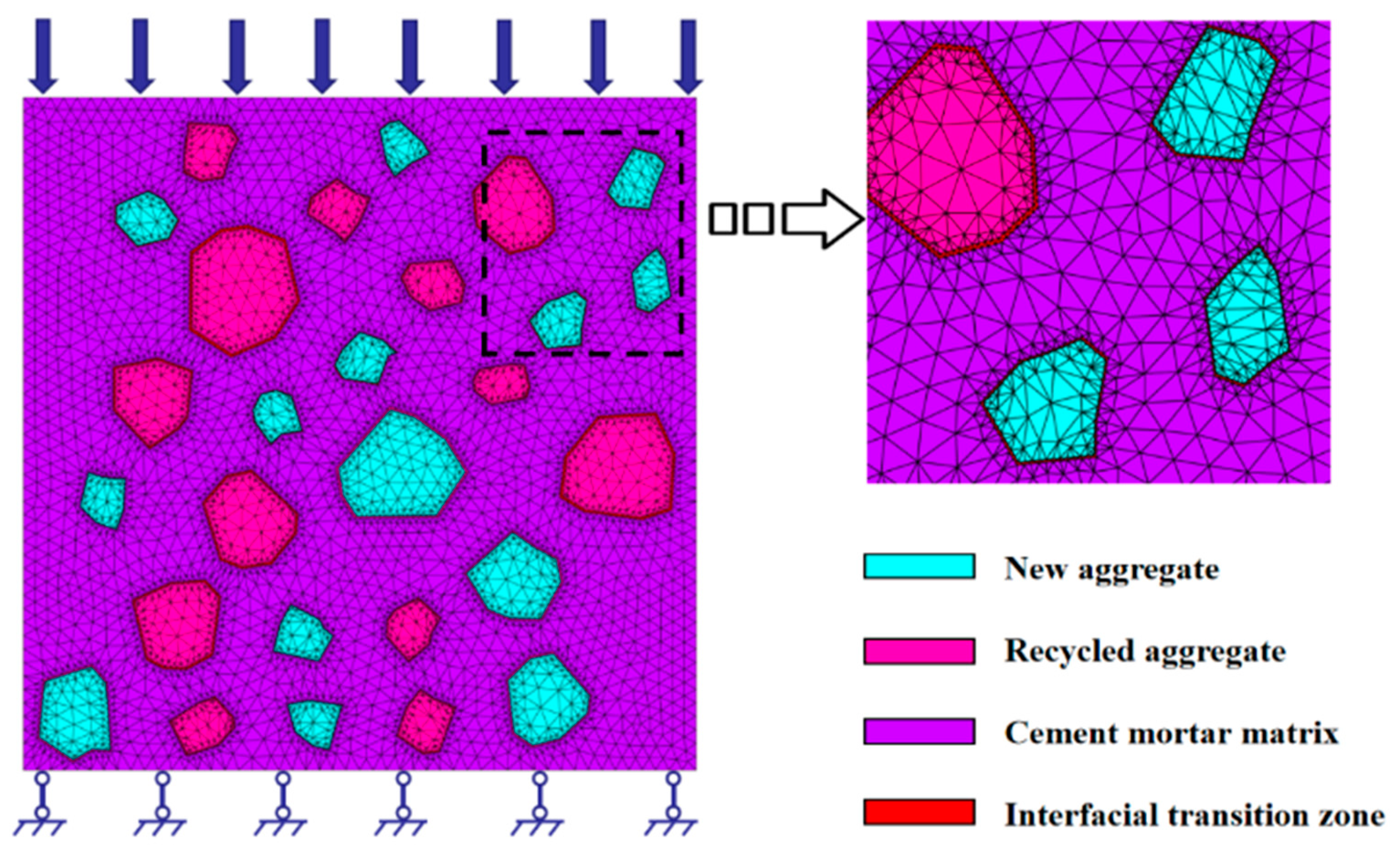
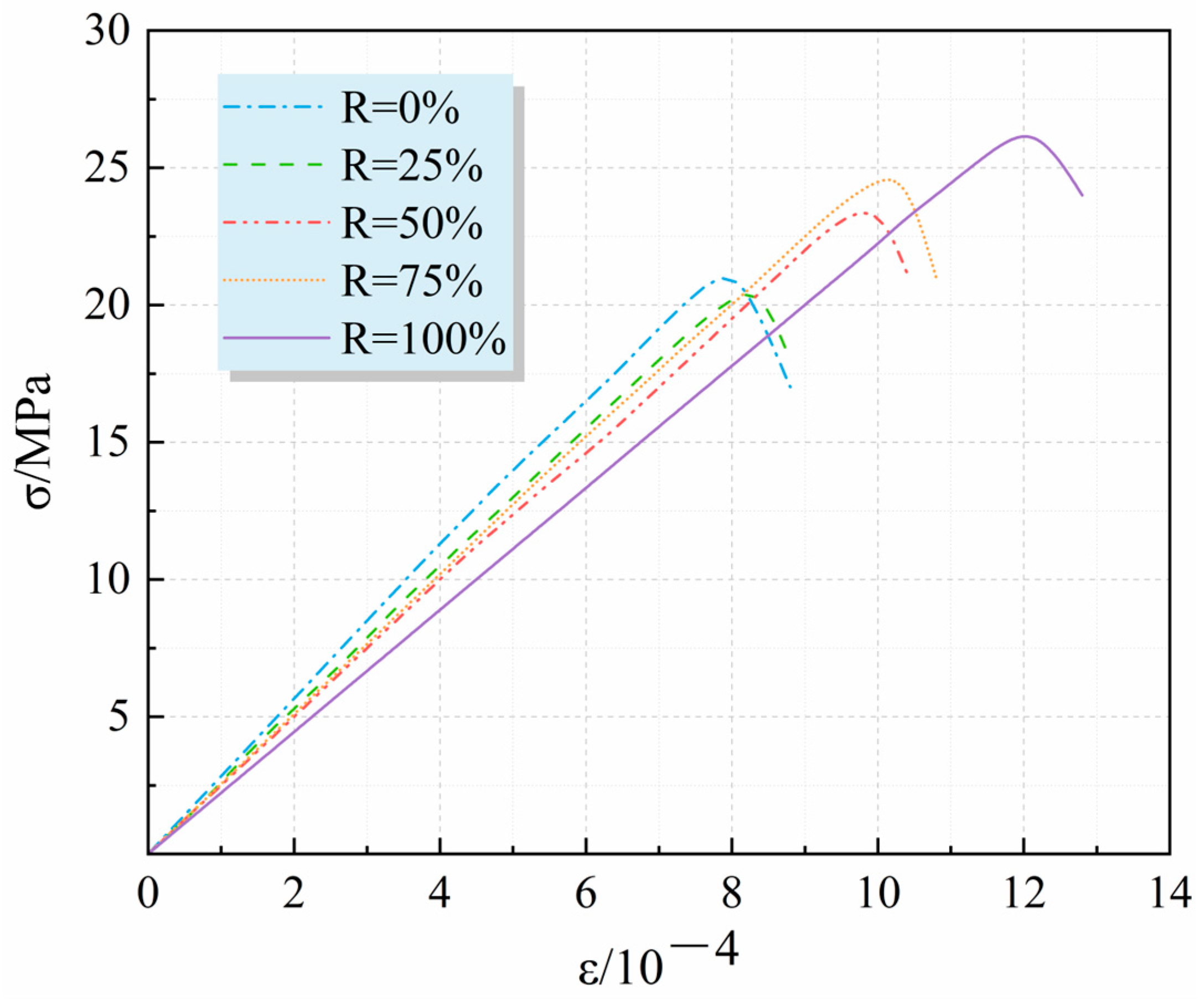
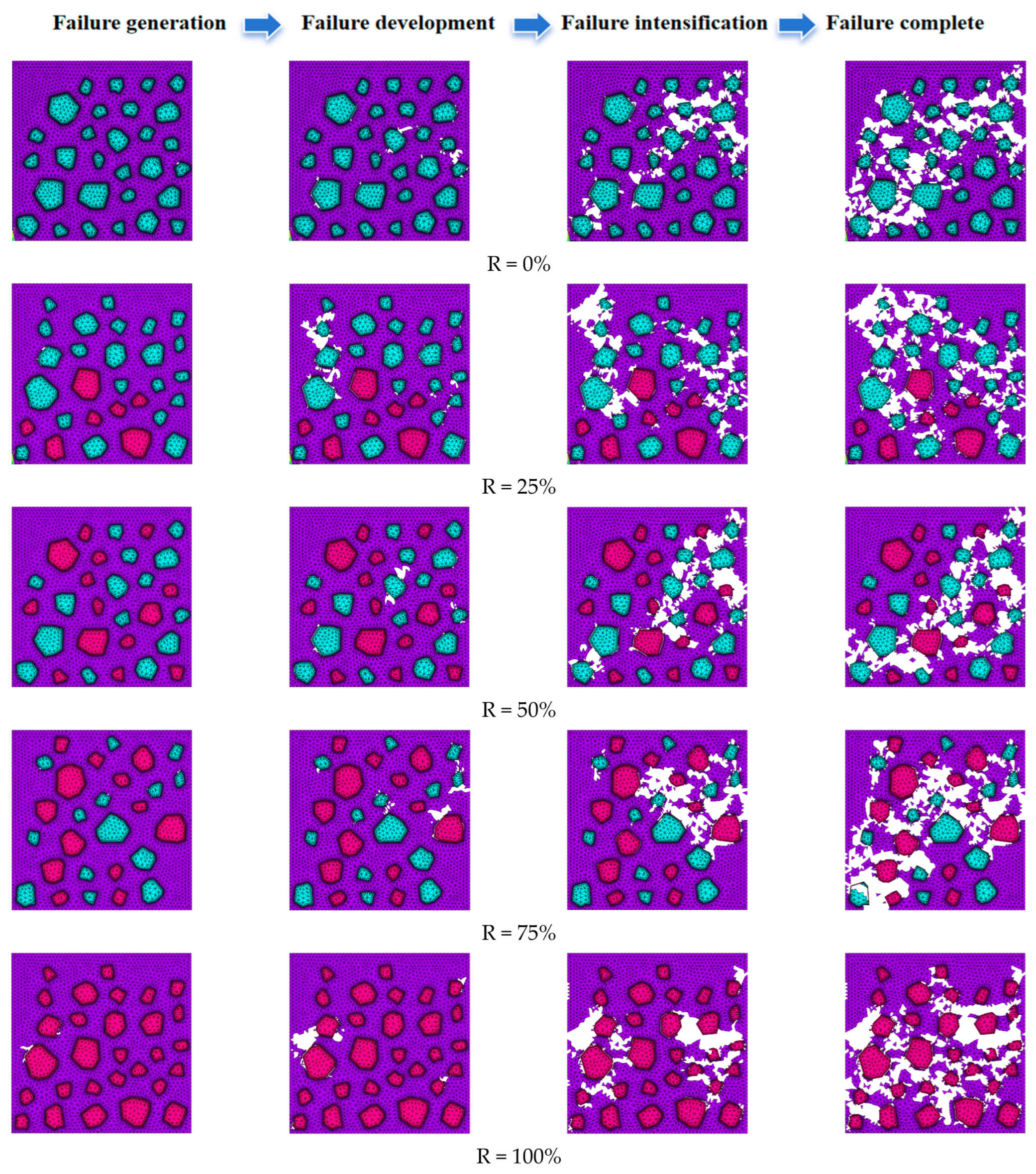
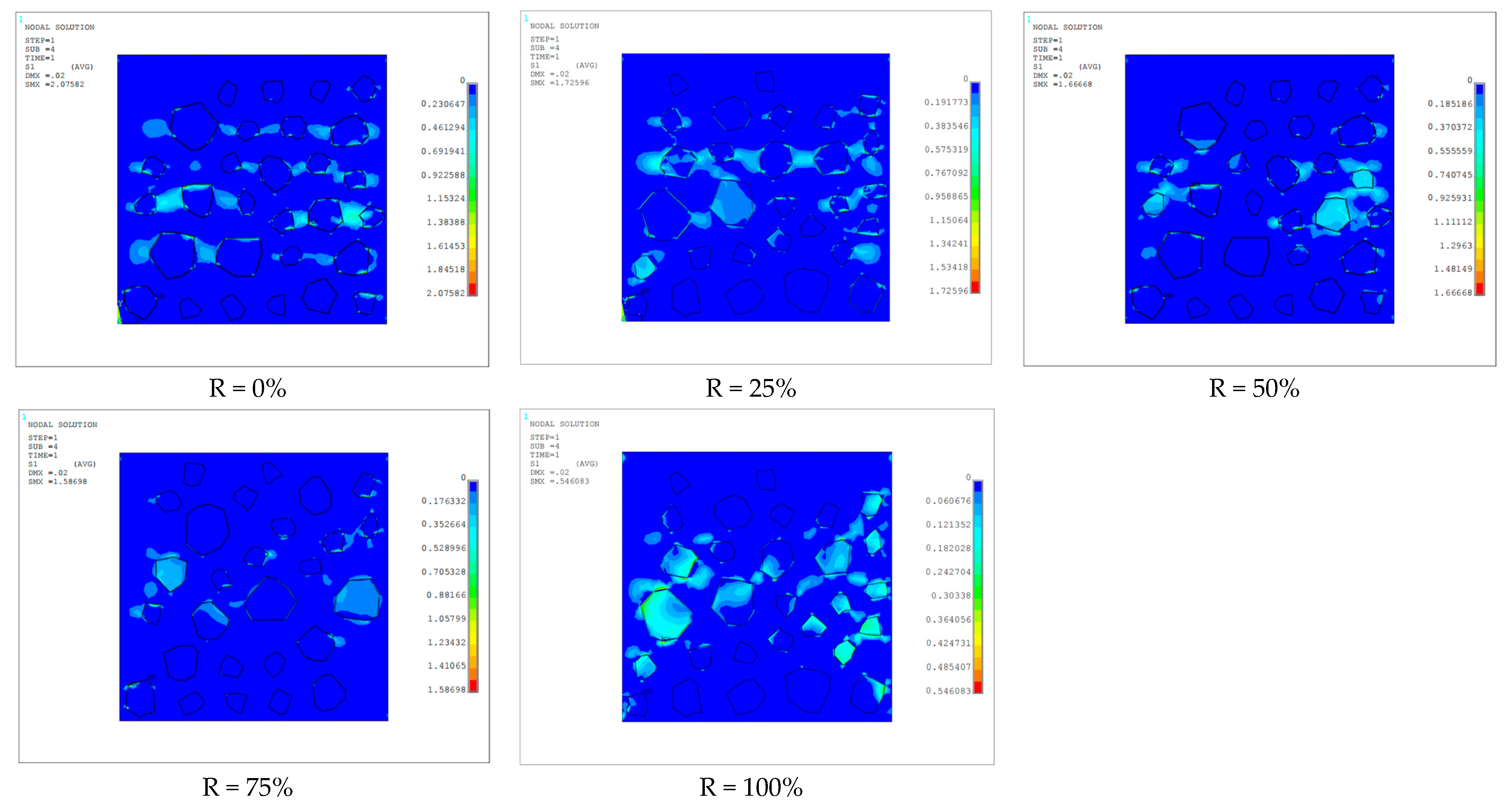
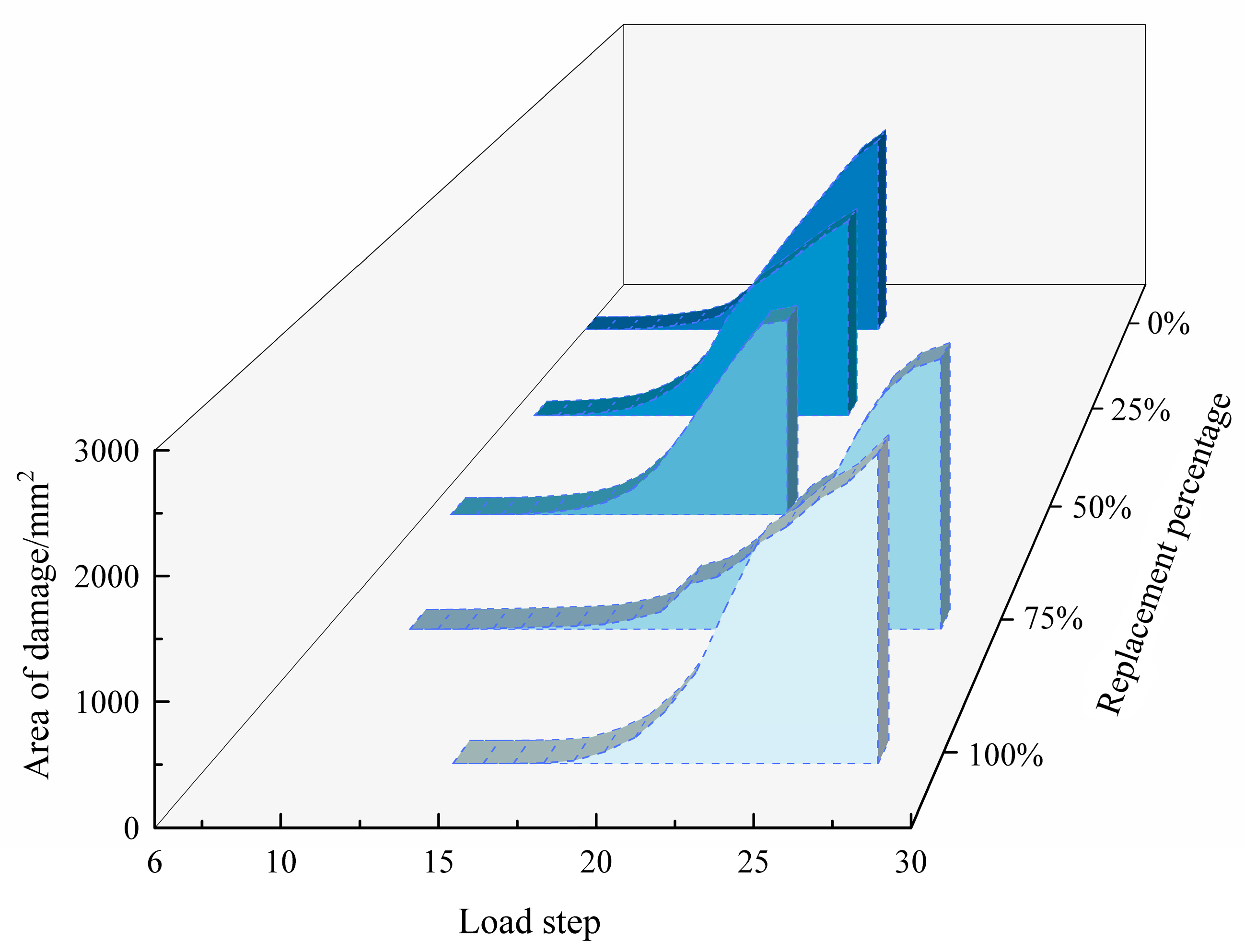

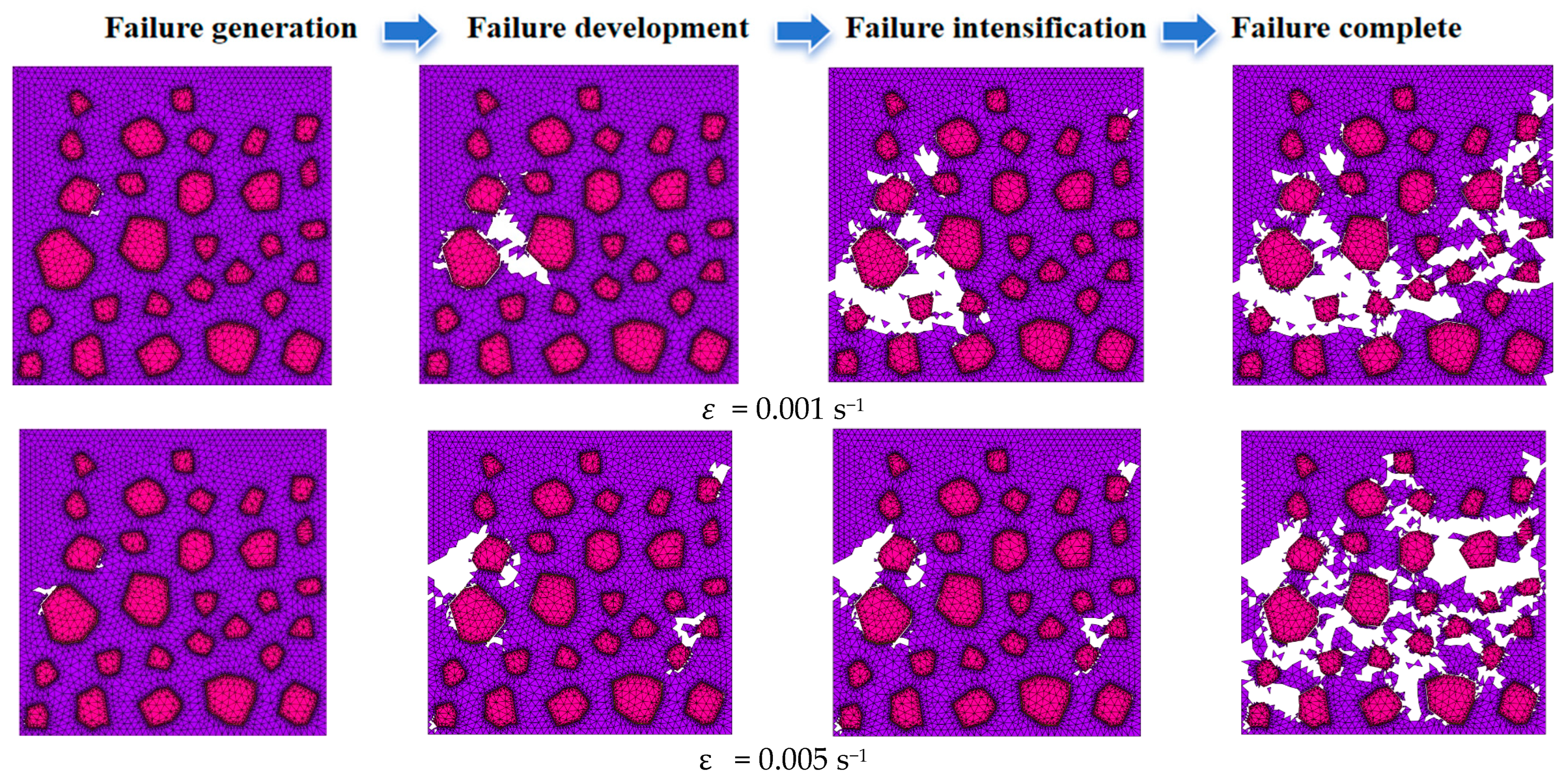

| Mesoscopic Component | Elasticity Modulus/MPa | Poisson’s Ratio | Tensile Strength/MPa |
|---|---|---|---|
| Natural aggregate | 70 | 0.16 | 10 |
| Recycled aggregate | 32 | 0.167 | 3.2 |
| Cement mortar | 25 | 0.2 | 3.0 |
| Interfacial transition zone | 14 | 0.22 | 1.4 |
| Regenerated Aggregate Replacement Rate | Failure Load Beginning Steps | Failure Load Completion Steps | Final Damaged Area/mm2 | Final Destruction Area Growth Rate |
|---|---|---|---|---|
| 0% | 5 | 14 | 2100.18 | 0% |
| 25% | 6 | 14 | 2024.69 | −3.59% |
| 50% | 6 | 13 | 1885.41 | −10.23% |
| 75% | 8 | 20 | 2426.41 | 15.53% |
| 100% | 13 | 15 | 2560.81 | 21.93% |
Disclaimer/Publisher’s Note: The statements, opinions and data contained in all publications are solely those of the individual author(s) and contributor(s) and not of MDPI and/or the editor(s). MDPI and/or the editor(s) disclaim responsibility for any injury to people or property resulting from any ideas, methods, instructions or products referred to in the content. |
© 2024 by the authors. Licensee MDPI, Basel, Switzerland. This article is an open access article distributed under the terms and conditions of the Creative Commons Attribution (CC BY) license (https://creativecommons.org/licenses/by/4.0/).
Share and Cite
Yang, A.; Shang, Q.; Zhang, Y.; Zhu, J. Research on Macroscopic Mechanical Behavior of Recycled Aggregate Concrete Based on Mesoscale. Materials 2024, 17, 2532. https://doi.org/10.3390/ma17112532
Yang A, Shang Q, Zhang Y, Zhu J. Research on Macroscopic Mechanical Behavior of Recycled Aggregate Concrete Based on Mesoscale. Materials. 2024; 17(11):2532. https://doi.org/10.3390/ma17112532
Chicago/Turabian StyleYang, Anyu, Qizhi Shang, Yanan Zhang, and Junlong Zhu. 2024. "Research on Macroscopic Mechanical Behavior of Recycled Aggregate Concrete Based on Mesoscale" Materials 17, no. 11: 2532. https://doi.org/10.3390/ma17112532
APA StyleYang, A., Shang, Q., Zhang, Y., & Zhu, J. (2024). Research on Macroscopic Mechanical Behavior of Recycled Aggregate Concrete Based on Mesoscale. Materials, 17(11), 2532. https://doi.org/10.3390/ma17112532






